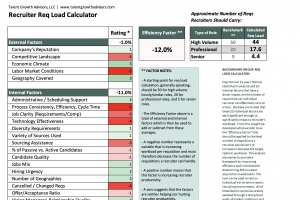8 Keys to Ensuring Your Newly Hired Black Executive Fails: A Case Study

Over the last few months, my work and personal lives, which I try hard to keep separate, have come together in a way I couldn’t have predicted.
In the course of my job leading a talent management consulting firm, I’ve worked for many years with global, Fortune 500 clients seeking to improve hiring and retention results. These organizations want to improve the speed and quality of hiring and are, often, ready to make dramatic changes. We keep tabs on industry trends and benchmarks regarding talent issues and, with one exception, not much has changed over the years: organizations want to hire faster and better – and it’s hard work to make that happen consistently.
But the exception – the something new – taking place in the US: organizations are genuinely and aggressively interested in increasing the number of people of color – specifically Black talent – in leadership positions. The pivot point of course was the George Floyd murder, the subsequent worldwide marches against systemic racism, and the plethora of heartfelt #BLM advertising campaigns. Plus, the overwhelming data is no longer easily ignored:
- There is a dramatically low number of Black leaders in corporate America
- Workplace diversity leads to improvements in enterprise value, innovation and global economic outcomes
- Most efforts by organizations to attract, hire and retain high-performing Black talent in meaningful ways, including the appointment of Chief Diversity Officers, have failed.
For some organizations, the confluence of these factors has forced a bona fide reckoning that has led them to significant investment in improving the diversity of their workforce in a measurable and sustained way.
Other organizations, however, simply want to move a few Black people into high visibility jobs to showcase the notion that they are leading in this area. Indeed, examples of poor employment practices negatively affecting Black employees more significantly than their White counterparts abound. When newly-hired or promoted Black leaders are put into positions prematurely or inappropriately, it feeds racist notions of inferiority (“See what happens when we put a Black person in a position like this?”), leads to acts of ‘talent sabotage’ (“They got hired over all these other people – let them figure out how things work around here”) and ultimately harms the overall workforce and the business.
Proper recruiting, selection, onboarding and performance management routines are critical for the success of any new executive, but particularly for companies seeking to expand diversity among their leadership ranks. The old routines that may have worked reasonably well with primarily White leaders need to be examined and adapted to successfully and consistently win top, diverse talent.
While I spend my days helping organizations solve their talent challenges, I’m also the parent of two students in Atlanta Public Schools, which has experienced a year more tumultuous than most. And here is where I’ve found myself at the intersection of my work and personal lives.
Atlanta Public Schools is one of the top 100 largest school districts in the country with 56,000 students, nearly 4,000 employees and a budget of $854M. It serves a giant and complex swath of our city with communities representing great differences in wealth, race and access to resources. APS became infamous for a widespread cheating scandal that began in 2008 and consumed the district – and the trust of parents – for years.
Fast forward a dozen years: as COVID was bearing down on our nation, the APS board elected to terminate the six-year employment of the previous superintendent for reasons that remain unclear. Meria Carstarphen, in addition to being a woman of color, was by objective accounts successful, widely admired, and responsible for gaining back much-needed trust in the school district. As the first COVID wave hit and schools closed, the board moved to recruit and interview candidates for the superintendent role. In June of 2020, with an inexplicable determination unaffected by the pandemic, the board announced it had successfully hired Dr. Lisa Herring, an African American woman and the "sole finalist", away from her three-year stint as Superintendent of Birmingham (AL) City Schools.
As an uninvolved (and, other than through news accounts, largely uninformed) observer of this transition, I can’t help but marvel at what a colossal failure these decisions and this transition have been. After only seven months on the job, Herring is seen by most as failing in her role as APS Superintendent. My objective, however, is not to criticize her, but rather the forces, people and assumptions that sought her out, wooed her, put her into this role during a pandemic, and then turned their back on her.
Conveniently yet tragically, we can use the APS Superintendent hiring fiasco as a case study of what not to do if your goal is to increase the ranks of qualified Black employees in leadership roles.
Here are eight steps to ensure a newly hired and well-qualified Black executive fails quickly:
- Mysteriously terminate the employment of the previous, well-liked, highly visible and widely admired incumbent. Never explain why the person was terminated so questions, rumors and frustration swirl. This ensures the new person will have to endure resentment, comparisons, questions and criticisms from the get-go.
- Fail to help the internal and external stakeholders understand why the new hire is a good fit for the job by referencing or clarifying their background, qualifications, accomplishments or education. Briefly state only a few highlights of their career in press releases. Don’t insist they clarify, even for PR reasons, their confusing Linkedin profile which shows multiple roles, in different cities, at the same time. This will encourage more people to conclude that the only reason they were hired was because they are Black.
- Start the new hire at a time when there is great disruption in the organization so an effective onboarding experience is impossible. COVID is a perfect time to ensure all regular operations have ceased, face-to-face meetings with stakeholders cannot take place, an understanding of the current state cannot be captured in an adequate or timely way, and Zoom must be the primary medium for all communications.
- Don’t engage key stakeholders in the hiring or orientation process and if pressure campaigns take form, don’t listen or respond to them. This way, stakeholders such as parents, principals, staff and direct reports do not get their concerns or questions addressed, nor do they get to understand the business reasons for making a change at such an inopportune time. Likewise, the new hire doesn’t get the opportunity to ask questions about the current state, challenges, priorities or tips for success in leading the organization forward.
- Expect the new hire to stretch their skills, knowledge and experience to a level of complexity and risk they’ve never approached before. Just assume that if they’ve led an organization that’s, say, half the size (APS is 2x the budget, staff and students at Birmingham City Schools in this case), they can probably figure it out. During a pandemic.
- Make sure the new hire has never held a similar job long enough to demonstrate the ability to drive sustainable, measurable improvement over years’ worth of annual/organizational cycles. Dr. Herring made great progress in Birmingham, bringing the school system up from an “F” to a “C” rating, but left before she could prove her strategy and management approach didn’t just achieve the basics, but in fact drove sustainable and continuously improved outcomes over time.
- Don’t adequately assess the new hire’s ability to formulate a different strategy, influence others, lead a team, and manage a truly challenging and unique group of stakeholders. Don’t probe into their approach to building relationships, assessing the current state, developing a business plan, holding their team accountable, making data-based decisions, measuring success or planning for how to handle their first 90 days on the job. In fact, if you can, be sure all those responsible for making the hiring decision have very little if any experience making strategic hires, running a business, leading a large and complex team, or being responsible for running the equivalent of a F1000 company.
- When things start getting a little rough, take active and immediate steps to distance yourself from the new hire. Make public statements about how the leader alone is responsible for the critical and questionable decisions that have been made. The Atlanta Public Schools situation provides a great case study in how to do this well: school board Chairman Jason Esteves has stated publicly multiple times that the decision regarding how and when to open schools during COVID is “not within the board’s authority” and is the sole responsibility of the superintendent.
At this point you may be wondering, wouldn’t this cause any new hire to fail, not only Black executives? The answer is of course, yes. Many people wouldn’t be able to overcome some, not to mention all, of these factors. But the data prove that Black executives are kept from the opportunities that allow them to succeed more often than their White counterparts. If the objective is to successfully place more Blacks in leadership positions in which they are able to succeed over time, addressing these failure points is not only the least an organization can do, but it's table stakes.
The extent of the damage done to APS, Dr. Herring herself, the students in both the Atlanta and Birmingham school districts, teachers, staff and community is unknown. But what we do know is this: the “hiring managers” – in this case, the APS Board of Education – failed. They are responsible for making a dramatic and, I would argue entirely unnecessary, personnel move at the worst possible time and doing it without a modicum of talent management or business acumen. Their decisions will likely have devastating and long-term outcomes for staff and students. And, perhaps just as bad, they’ve made it easy for destructive assumptions, stereotypes, and whispers to continue – no matter how unjust and untrue: “See what happens when you put a Black person into a job like this? They just can’t succeed.”
Organizations must do better if their sincere goal is to successfully hire Black talent into leadership roles. It’s not rocket science, but it does require disciplined yet basic talent management capability. We can’t successfully deal with micro-aggressions or train employees in anti-racism skills if we can’t get basic selection and onboarding practices right. Our new hires, particularly Black executives, deserve no less.
Share this Article
Learn more about our unique approach to Talent Strategy Formulation.



